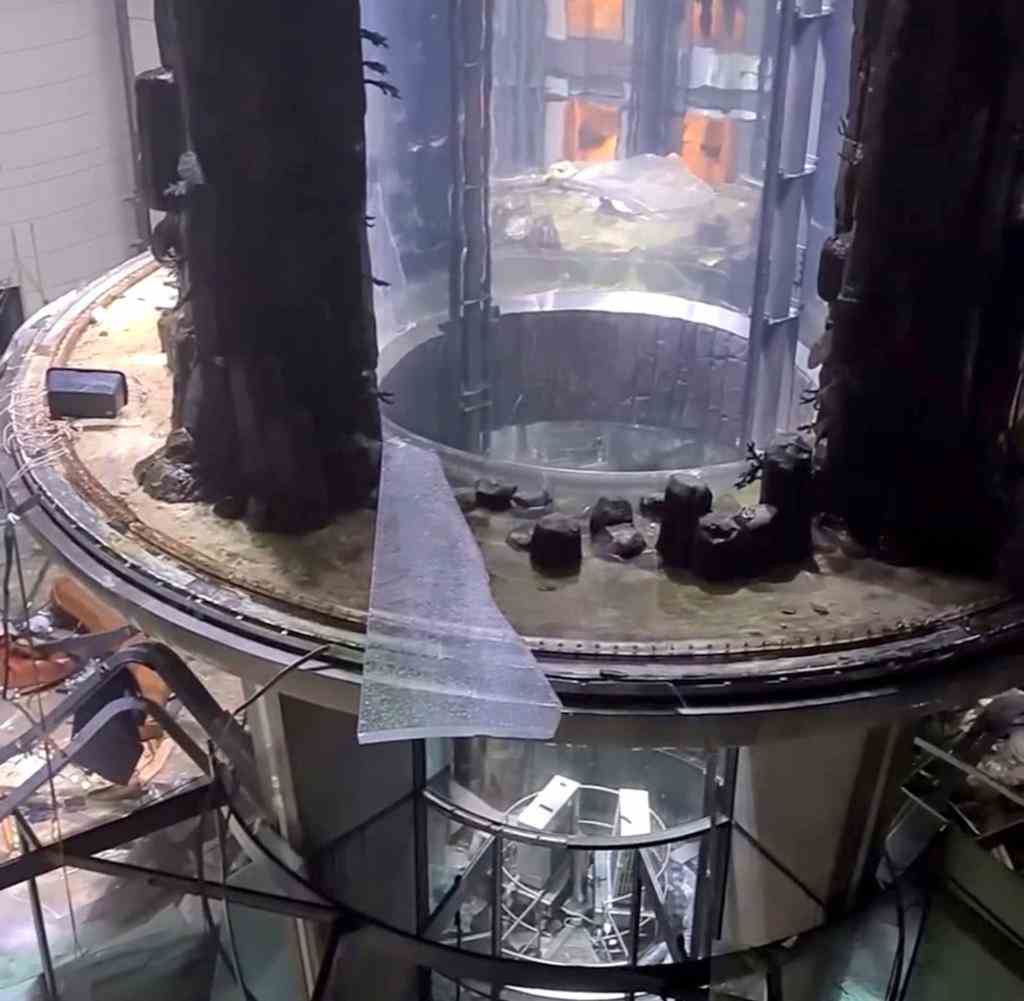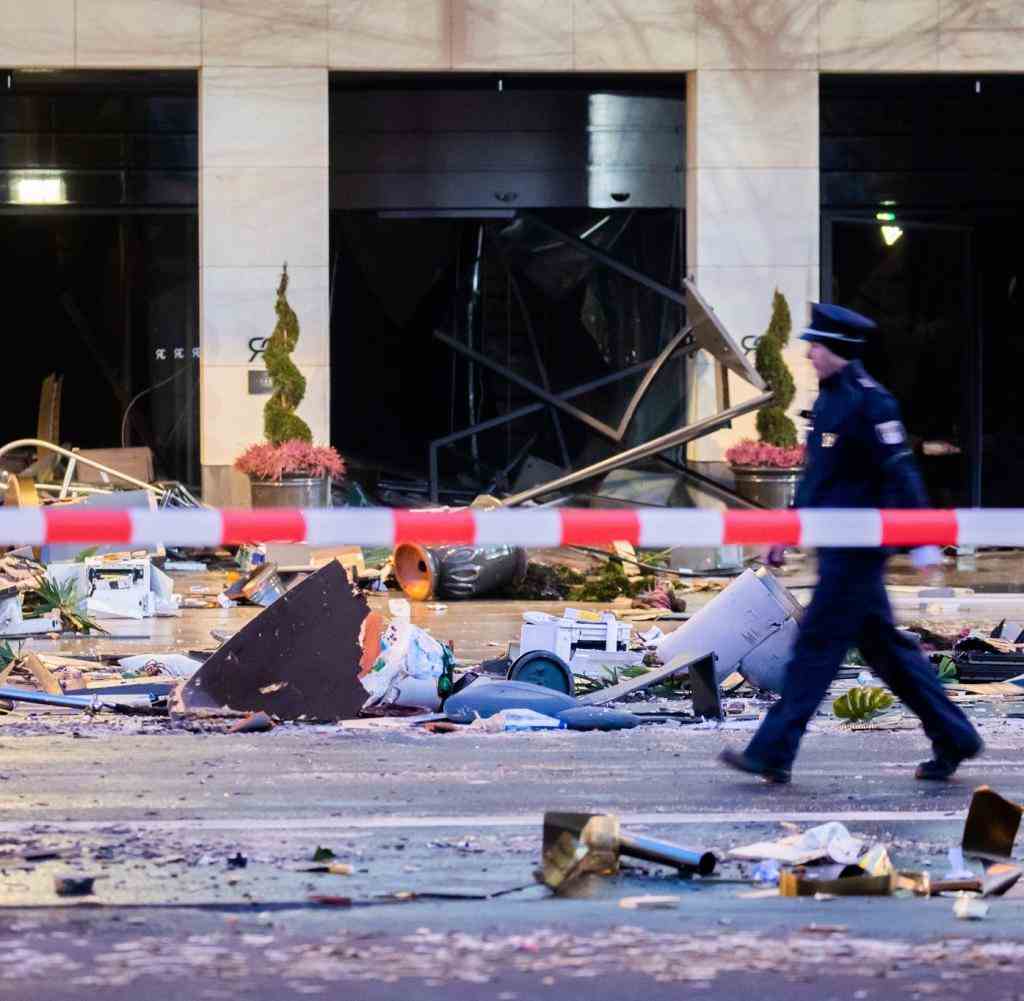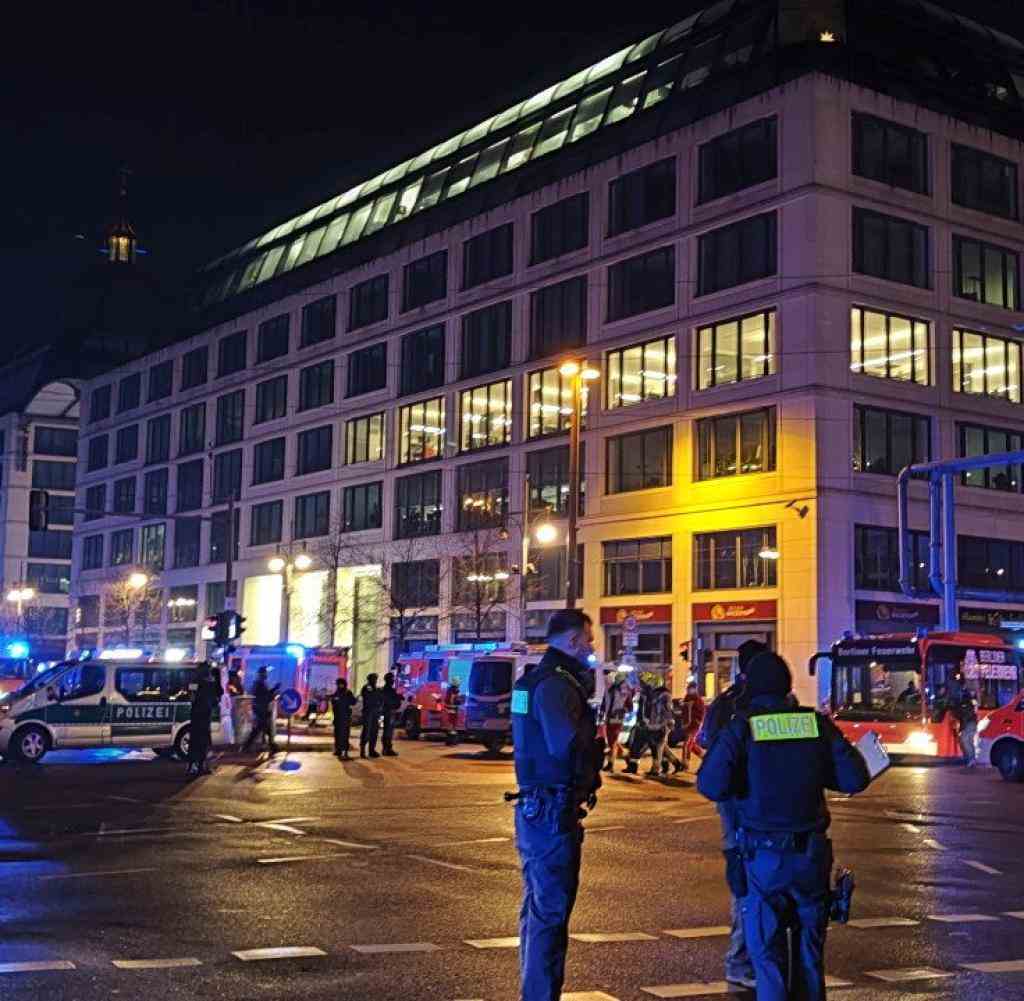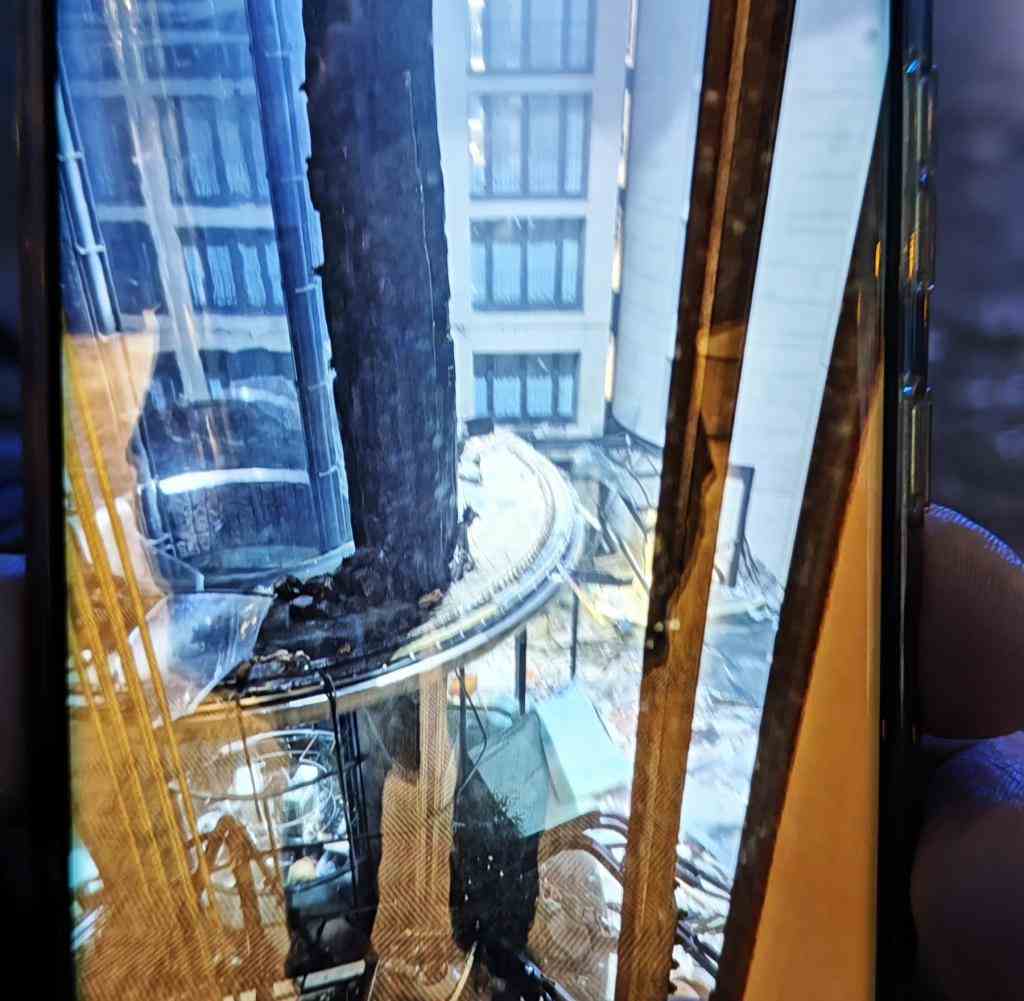Ein the large aquarium in Sea Life in a hotel in the immediate vicinity of the Berlin Cathedral was destroyed, two people were injured and taken to the hospital. According to the police, the free-standing Aquadom, a 16-meter-high acrylic glass container with 1,500 fish, burst. Most of the fish are dead and must be disposed of with the debris, a fire department spokesman said. Civil engineers and the Technical Relief Agency (THW) would now check whether the hotel building should remain closed. After that, the first clean-up work could begin. According to the police, there was initially “no evidence of a crime” in connection with the spectacular case.
A few dozen fish were found alive in the lower part of the burst vessel. Special forces would have recovered them, said fire department spokesman James Klein. “In terms of number, I think there were about three vats,” says Klein. These are freshwater and saltwater fish.
The saltwater fish are therefore coming to the neighboring Sealife underwater world with other aquariums. The freshwater fish are to be brought to the zoo’s aquariums on Saturday. “So as not to expose them to the stress today,” said the spokesman. In addition, all the fish were saved in the basement of the hotel building, which housed the large aquarium in the form of a huge glass cylinder. There are twelve aquariums with saltwater fish. According to Klein, these were brought to Sealife.
Sea Life emphasizes Aquadom’s independence
The Sea Life teams offered support to the Aquadom teams. “Our team is working hard to prepare all available habitats to support the fastest possible housing of Aquadome animals that need our help.”
At the same time, Sea Life emphasized that the Aquadom is “an independent attraction and is not owned by Sea Life Berlin, and maintenance and repairs are not the responsibility of Sea Life Berlin”. Although the visit to the large aquarium was included in the tickets and marketing activities, the Union Investment company is the owner. “We market the Aquadom,” said a Sea Life spokeswoman.
View of the destroyed elevator
Source: dpa/Iva Yudinski
The company that owns the destroyed Aquadom large aquarium in Berlin has expressed its dismay at the accident. The reason for the bursting of the huge cylinder full of water is still “completely unclear,” said Union Investment spokesman Fabian Hellbusch on Friday. “We are currently trying to get a more accurate picture of the situation and the damage caused in coordination with the police and fire brigade on site.” You also have to speak of “luck in misfortune” when you consider what could have happened.
Berlin’s Governing Mayor Franziska Giffey (SPD) visited the scene of the accident on Friday. “It’s a veritable tsunami that spilled over the hotel premises and the adjacent restaurants.” There was great damage. It must now be examined how this could have arisen.
Structural engineers would now have to check the security of the buildings. A lot of water ran into the sewage system, but also into the basement and neighboring facilities – such as the DDR Museum. Giffey anticipated “major demolition work.”
“Like a War Zone”
Karin Wicki and Sandra Hoffmann, hotel guests from Switzerland, described: “Everything inside is destroyed. There are dead fish. All the furniture is destroyed. The panes are destroyed. Shards everywhere.” The FDP member of the Bundestag, Sandra Weeser, who had stayed at the hotel, said she was woken up in a deep sleep and initially thought of something like an earthquake. But there was only a short bang and a “short tremor of the building”. That’s why she fell asleep again. She then found out from the media what had happened in the hotel. The police and fire brigade then later informed the guests.
“I tried to contact the reception but they were no longer there”
The FDP member of parliament Sandra Weeser stayed in the hotel, which is attached to the Aquadom. She describes the minutes after the bang until three firefighters came into her room with a master key: “Where the aquarium was, there was only furniture, debris and dead fish.”
The hotel looks “a bit like a war zone,” Weeser said. “It’s a picture of devastation with a lot of dead fish and shards.” You’ve seen a lot of dead fish. “Those who might have been saved were frozen to death.”
Manfred Rank, Managing Director of the umbrella organization of German aquarium associations, told WELT: “But one wonders why it burst. It has only just been reopened,” Rank told WELT. That is very unusual. In an aquarium of this size, the weak point is usually the silicone and not the glass.
Notes on technical defects
The police were on Friday morning with 100 emergency services at the Hotel DomAquarée. A spokesman for the fire brigade told WELT that the fire brigade was alerted at 5:43 a.m. The aquarium was “completely destroyed” and the water flowed “uncontrolled” into all areas. The fire brigade was also on site with 100 emergency services.
A firefighter told WELT: “We can be glad that the aquarium did not burst later in the morning. Then there would have been very likely deaths.”
According to the police, there is no evidence of an attack.
“Of course, the investigation into the cause has not yet been completed, but the first signs point to material fatigue,” said Berlin’s Interior Senator Iris Spranger (SPD). Now it’s a matter of recording the damage and taking the necessary safety measures. Buildings and traffic routes would have to be checked.
Debris on Karl-Liebknecht-Strasse
Source: Christoph Soeder/dpa
The fire brigade and police were called early in the morning
Source: Morris Pudwell
The fire brigade is on site with 100 firefighters
Source: Morris Pudwell
According to the fire brigade, the giant container was destroyed in one fell swoop. “If the aquarium is defective, then it bursts suddenly,” said a spokesman for the fire brigade. “It’s not a small crack from which the water is leaking, but the entire aquarium suddenly burst.”
The fire brigade said that a large part of the water ran through the doors on the ground floor onto the street and there into the gullies. Not much water was found in the basements. The destroyed ground floor was searched for people with rescue dogs.
Aquadom extensively modernized just two years ago
Because of the severe damage, the guests of the surrounding hotel also had to leave the building, as a spokesman for the fire brigade said. Around 350 people were still in the hotel.
A video on Twitter showed the devastation in the hotel’s lobby:
According to the operator on the Internet, the Aquadom in Sea Life was the “largest, cylindrical, free-standing aquarium in the world”, an attraction in Berlin well-known to many tourists. It was an acrylic glass container 16 meters high and 11.5 meters in diameter. Visitors could ride through the interior of the aquarium in an elevator.
About 1,500 fish from over 100 different species lived in the tank. The aquarium was filled with a million liters of salt water. That would be 1000 cubic meters of water weighing 1000 tons. According to the information, the aquarium was extensively modernized by summer 2020.
A photo from inside the hotel
Source: world
The AquaDom before destruction
Source: pa/dpa/Annette Riedl
A modernization flyer stated that the seals of the Aquadom, which opened in 2004, would have to be renewed after 15 years. There was talk of a “world first”: “a double seal specially developed for this purpose that is particularly durable”.
Pools in the Sea Life underwater world in the immediate vicinity of the Aquadom are now checked for damage. Sealife consists of various aquariums and tanks with fish on the ground floor on the other side of the building. A tunnel allows visitors to walk through a large aquarium with sharks and rays.
Statics professor: No TÜV-like tests of the giant aquarium
According to the knowledge of the statics professor Jens Schneider from the Technical University of Darmstadt, the aquarium was not regularly subjected to a TÜV-like examination. Schneider is an expert in large glass constructions and knows the giant aquarium that has now collapsed. Before construction, the construction, including static calculations, would have to be approved by the authorities. However, there is no standardized regular inspection process, such as with elevators, Schneider said on request. He does not know whether there is an individual agreement with the building control authority.
Prof. Dr.-Ing. Schneider do not provide a hasty explanation. “I don’t have a concrete assumption yet,” said Schneider. He himself was surprised at the collapse of the giant aquarium.
The problem with such constructions is the permanent enormous water pressure on the thick Plexiglas construction, according to the expert. The individual elements were joined together using a special adhesive welding process. Aging processes, such as material embrittlement, could be the cause of the collapse of the structure. In addition, temperature fluctuations or microcracks on the surface are conceivable as triggers.
“In principle, micro-defects, for example caused by cleaning work, can also play a role,” says the expert. It is common for such large aquariums, underwater worlds or transparent swimming pools to be built from Plexiglas and not from the considerably heavy mineral glass, says Schneider. With conventional glass, seamless complete transparency across the entire construction would not be possible.
Peta wants to file a criminal complaint
The animal protection organization Peta wants to take legal action against those responsible. “We will file a criminal complaint against those responsible because the lives of around 1,500 fish were apparently handled negligently,” said a spokesman for the organization. The destruction of the aquarium is a “huge, man-made tragedy”. It should not be rebuilt.
The masses of water that were released when it burst also affected the DDR Museum. The museum is below the building complex on the banks of the Spree. “A million liters of salt water have made their way, also to us in the exhibition,” said museum director Gordon Freiherr von Godin.
Several rooms are affected, including exhibits and furniture. The exhibition area is about 1200 square meters, according to his estimate about 300 to 400 square meters are affected by the water damage. Nobody got hurt.







